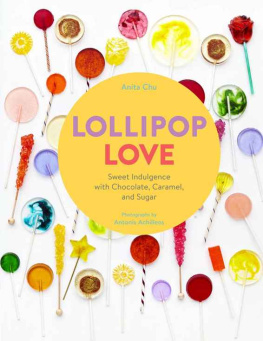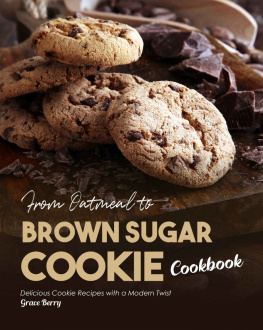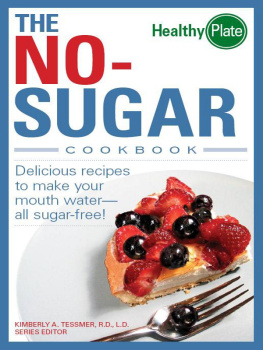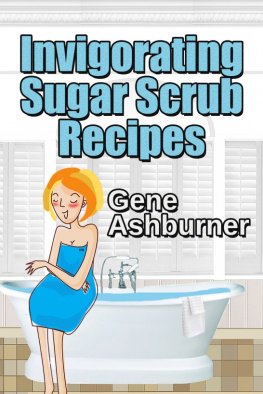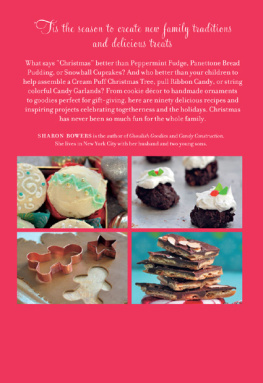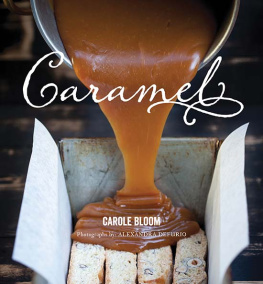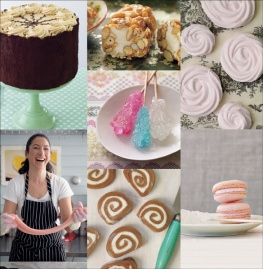

To Mike and Isabelle, the sweetest parts of my life.

TEXT COPYRIGHT 2015 BY ANITA CHU.
PHOTOGRAPHS COPYRIGHT 2015 BY ANTONIS ACHILLEOS.
All rights reserved. No part of this book may be reproduced
in any form without written permission from the publisher.
LIBRARY OF CONGRESS CATALOGING-IN-PUBLICATION DATA:
Chu, Anita.
Lollipop love : sweet indulgence with chocolate, caramel, and sugar /
Anita Chu ; photographs by Antonis Achilleos.
pages cm
Includes index.
ISBN-13 978-1-4521-2593-0 ISBN-10 1-4521-2593-7 ISBN 978-1-4521-3552-6 (epub, mobi) 1. Lollipops. I. Title.
TX791.C5593 2015
641.85'3dc23
2014015022
DESIGNED AND ILLUSTRATED BY AZI RAD
PROP STYLING BY CATHY COOK
FOOD STYLING BY CATHY COOK
TYPESETTING BY DC TYPE
Pop Rocks is a registered trademark of
Pop Rocks, Inc.
Chronicle Books LLC
680 Second Street
San Francisco, California 94107
WWW.CHRONICLEBOOKS.COM
CONTENTS
INTRODUCTION
Lollipops are the original sweet on a stick, the quintessential candy of childhood. I remember the brightly colored, cellophane-wrapped pops from the dentists office, the giant rainbow-swirled lollipops at the carnival, the round suckers with a chewy center that took a whole afternoon to finish. Today, lollipops are no longer just childs candy but a grown-up sweet. You can find them in flavors like espresso-rum and mango-chili, made with beer or champagne, and decorated with glitter dust, cacao nibs, and rose petals.
The history behind lollipops is delightfully colorful. In late-eighteenth-century England, street vendors sold sugar candy and called them lolly pops, lolly being slang at the time for tongue or mouth. The name could thus be interpreted as a sweet you could pop in your mouth. Although some sources claim that certain vendors did put their wares on sticks to make them easier for children to eat, in general, the term lolly pop did not mean candy on a stick. The words lolly pop, lollypop, and lollipop can be found in various dictionaries and publications from the time period, and even in some of Charles Dickenss novels.
Fast-forward to America in the early 1900s and enterprising businessmen were inventing machines that could automate many manufacturing processes, including candy making. Several companies lay claim to being the first to put sticks into their candies, although none of them called their products lollipops. Finally, the Bradley Smith Company brought the candy-on-a-stick concept and the words lolly pop together when one of the owners, George Smith, trademarked the term in 1931 to specifically describe his sugar candies on a stick. Company lore states that Smith took the name from his favorite racehorse, Lolly Pop, and not the old British term. Whether he was aware of the history behind the phrase lolly pop, or it was just a fantastic coincidence, is an unanswered question.
Sadly for the Bradley Smith Company, it went out of business during the Great Depression and the trademark ran out, freeing it up to be used for an endless variety of candies stuck on a stick. Today, lollipops in all shapes and flavors can be found, ranging from traditional hard sugar to caramels. When most people hear the word lollipop, though, they still think of a hard sugar candy perched on a stick.
Candy making might seem intimidating, since it requires thermometers and molds and involves sugar being cooked to bubbling hot temperatures, but in reality lollipops are some of the easiest candies to make. The ingredients for a simple lollipop can be found in nearly anyones cupboard, and even without lollipop molds you can still make some pretty pops.
Once you start delving into the wide world of different molds and decorations, you can start really making your lollipops unique. Thanks to the Internet, there are molds available for nearly every occasion or theme you can imagine. Many of the decorations used in baking, such as edible glitter and sprinkles, can be used to decorate lollipops as well. Lollipops can be quickly made for an unexpected after-school treat or can be fancied up to serve as party favors.
In this book, youll find recipes for a variety of lollipops, from traditional clear sugar pops to ones made from caramel or chocolate. There are classic dime-store flavors like super lemon and red hot, and modern flavors like maple-bacon-walnut and passion fruitcaramel. Old-fashioned styles of lollipop, like barley sugar pops and rock candy, are also included, as well as lollipops with newer ingredients, like agave syrup and Pop Rocks. Once you start making lollipops, youll realize that the possibilities are endless. Its time to get sweet!
INGREDIENTS
CHOCOLATE
Most baking chocolates can be used for the recipes in this book. Higher-quality chocolate brands, especially ones marketed to professionals, will likely melt and temper more easily, but its not necessary to buy the most expensive chocolate; simply use one that you enjoy. Two of my favorite brands are Guittard and Scharffen Berger, both relatively affordable chocolates that are widely available and perform well in baking and candy making. Be sure to use pure chocolate and not chocolate chips or chocolate candy bars, as they contain additional ingredients that will prevent them from tempering properly.
COLORINGS
Liquid (water-based) and gel paste food colorings both blend well into lollipops, although gel colorings will give you the most intense results because they are more concentrated.
CORN SYRUP
Corn syrup is mainly used in candy making to help prevent crystallization. Use light corn syrup to avoid adding color to your lollipops. (Note that light refers to the color, not lite as in low-calorie. The most common forms of corn syrup youll find at the grocery store are light and dark.)
DECORATIONS
Using edible glitter, disco dust, or another edible decorating dust is one of the easiest ways to decorate your lollipops. You can swirl some into the sugar syrup before you pour it out or you can fill half the lollipop mold with sugar syrup, sprinkle some glitter over the lollipops, and then fill up the rest of the mold to create a beautiful sparkling layer within the lollipops.
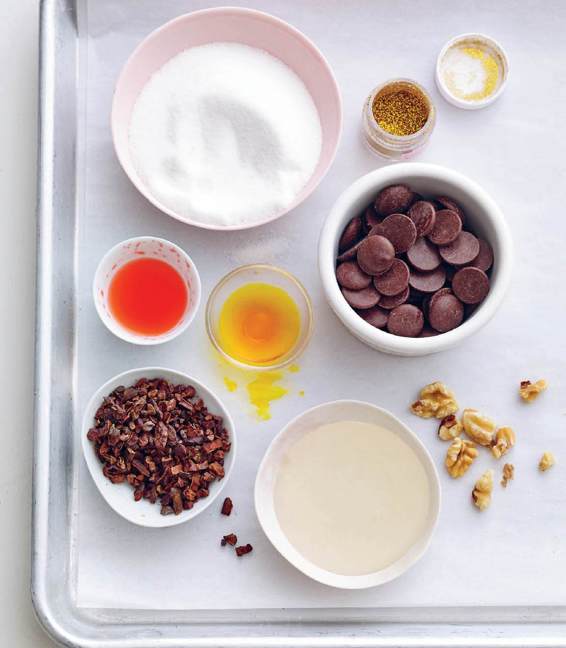
Other traditional edible decorations made of sugarsuch as sprinkles, drages, or sparkling sugarscan also be used to decorate lollipops, but as they might melt or get stuck in a candy funnel if youre using one, they are better sprinkled over the tops of lollipops after theyve been poured and before theyve fully set.
FLAVORINGS
Most of the recipes in this book rely on natural ingredients to add flavor to the lollipops. However, the more traditional approach is to use candy flavoring oils. These highly concentrated oils work well in lollipops because water- or alcohol-based extracts will evaporate in the high heat of the cooking sugar. Candy flavoring oils are more concentrated than extracts, meaning youll get stronger results with less product. If youd like to experiment with some more fanciful flavors like marshmallow or cotton candy, these oils are an easy option. The wide range of flavors available means you can make a huge variety of lollipops simply by adding different flavors to the sugar syrup. Some flavors work better than others depending on the brand and your personal taste.
Next page
